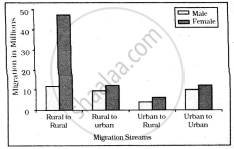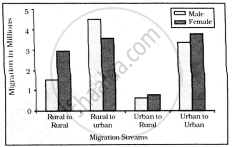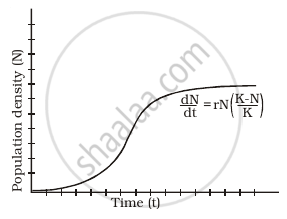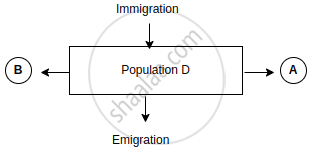Advertisements
Advertisements
प्रश्न
Analyse the different aspects of population growth in India during 1901-1921 and 1921-1951.
उत्तर
- Phase-I - 1901-1921:
- The period from 1901-1921 is referred to as a period of stagnant or stationary phase of growth of India’s population, since in this period growth rate was very low,
- Even recording a negative growth rate during 1911-1921.
- Both the birth rate and death rate were high keeping the rate of increase low.
- Poor health and medical services, illiteracy of people at large and inefficient distribution system of food and other basic necessities were largely responsible for a high birth and death rates in this period.
- Phase-II - 1921-1951:
- Period of steady population growth.
- An overall improvement in health and sanitation throughout the country brought down the mortality rate.
- At the same time better transport and communication system improved distribution system.
- The crude birth rate remained high in this period leading to higher growth rate than the previous phase.
APPEARS IN
संबंधित प्रश्न
If 8 individuals in a population of 80 butterflies die in a week, calculate the death rate of the population of butterflies during that period.
If the birth rate is greater than the death rate then the population ______.
Examine the following statement and correct the incorrect one.
There is an adverse impact on manpower in the regions of out-migration.
Identify the correct correlation :
A: Assertion; R: Reasoning
A: Population of a region does not change.
R: Birth rate, death rate, and migration affect the population of a region.
Identify the correct correlation :
A: Assertion; R: Reasoning
A: In stage 2, the death rate reduces but the birth rate is constant.
R: The population increases rapidly in stage 2.
Give a geographical reason:
Population may increase though birth rates are low.
Differentiate between
Crude Birth Rate and Crude Death Rate
Which one of the following is not a push factor?
Birth rate and death rate.
Push factors and pull factors of migration.
What is the impact of migration?
What is population growth? What does population change indicate for an area?
What are the components of population change?
Distinguish between the place of origin and the place of destination.
What is the trend in growth of population over the years in the world?
Why do people migrate in large numbers from rural to urban areas in India?
How many stages/phases of population growth?
What is the average sex ratio In India (2011)?
The continent that has the highest growth rate of population.
Which of the following is not a pull factor?
Population increased by the difference between births and deaths in a particular region between two points of time.
The country having lowest growth rate of population.
How many times the world population has increased during the last 500 years?
The ten most populated countries have a ______ world population.
Which of these statements is not true?
When the birth rate is more than the death rate between two points of time, it is known as ______
Study the given graph carefully and answer the following question:

Intra-state Migration by place of Last Residence Indicating Migration Streams India, 2011

Inter-state Migration by Place of Last Residence Indicating Migration Streams India, 2011
Who dominates the intra-state migration of short distances?
On the basis of the demographic data of a country given below, construct an age pyramid and explain whether the population is stable, declining or growing.
| Age group | No. of individuals |
| Pre-reproductive | 20,000 |
| Reproductive | 15,000 |
| Post-reproductive | 10,000 |
Ratio between mortality and neutrality is called ______.
In an exponential bacterial culture, the number of cells/ml is plotted o half log group. The growth is ______.
Which of the following statement is true?
(i) CBR = Bi/P × 1000
(ii) COR = D /P × 1000
(iii) If birth rate is more than death rate, then CBR results in positive growth of population.
The term Crude Birth Rate (CBR) is closest to which of the following?
Which of the following formula correctly depicts natural growth of population?
India's population is larger than the total population of which of the following?
In the exponential growth equation Nt = Noert, e represents ______
Comment on the growth curve given below.

Swathi was growing a bacterial colony in a culture flask under ideal laboratory conditions where the resources are replenished. Which of the following equations will represent the growth in this case?
(Where population size is N, birth rate is b, death rate is d, unit time period is t, and carrying capacity is K).
Which of the following may be interpreted as a spontaneous effort to achieve a better balance between population and resources?

Observe the schematic representation given above and answer the following questions:
- Identify A and B.
- Calculate the growth rate of bacteria in a curd sample, where 1 million bacteria increased to two million, within a period of one hour.
Analyse the main features of Phase-III (1951 - 81) of growth of population in India.
Examine the different aspects of the growth of population in India during 1951-1981 and 1981-2021.
Consider the following and choose the correct answer with the help of given codes-
| STAGES OF POPULATION | GROWTH FEATURES |
| I Period between 1901 to 1921 | 1. Period of steady growth |
| II Period between 1921 to 1951 | 2. Phase of stagnant growth of Population |
| III Period between 1951 to 1981 | 3. High but decreasing growth rate |
| IV After 1981 till present | 4. Period of population explosion |
Assertion (A): Population of a region does not change.
Reasoning (R): Birth rate, death rate and migration affect the population of a region.
Which one of the following is the largest linguistic group of India?
Assertion (A): The population of a region does not change.
Reasoning (R): Birth rate, death rate and migration affect the population of a region.
A: The population of a region does not change.
R: Birth rate, death rate and migration affect the population of a region.
Assertion (A): Population of a region does not change.
Reasoning (R): Birth rate, death rate and migration affect the population of a region.
Assertion: Population of a region does not change.
Reason: Birth rate, death rate and migration affect the population of a region.
Assertion: Population of a region does not change.
Reasoning: Birth rate, death rate and migration affect the population of a region.
Assertion : Population of a region does not change.
Reasoning : Birth rate, death rate and migration affect the population of a region.
